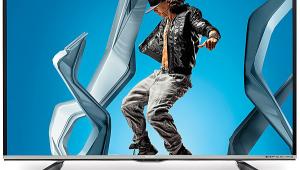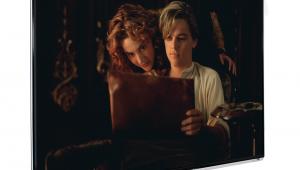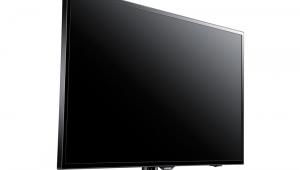LG 55LM9600 3D LCD HDTV
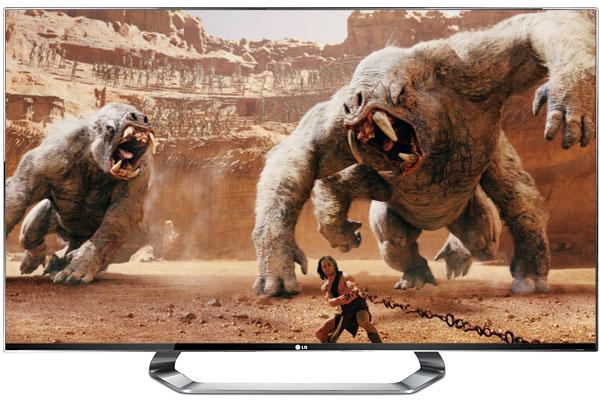
The pick of the litter in today’s LCD HDTV designs is full LED backlighting with local dimming. Such sets first appeared in 2008, but the process of positioning clusters of LEDs behind the screen was, and is, expensive. While LCD sets with LED lighting have now become ubiquitous, most of them use edge lighting (sometimes with a limited form of dynamic dimming, sometimes without) in which a smaller number of LEDs are located at the borders of the screen. This both keeps the price down and enables slender, more stylish sets.
LG recently launched a new range of local dimming models with full LED backlighting carrying the Nano designation. This technology imbeds the LED clusters in a membrane behind the screen and is said to produce the benefits of full local dimming, including uniform illumination of the screen, in a thin design. There are currently two Nanos: 47 inches and 55 inches.
Description
The front bezel of the 55-inch (diagonal) 55LM9600 is less than 0.7 inches thick (about 17 mm), and that’s what draws your eye. The middle of the back panel steals a bit more depth, and a bulge at the bottom (enclosing the speakers and possibly other circuitry) adds up to the specified overall depth of 1.5 inches. A brushed-aluminum band surrounds the set’s virtually frameless perimeter. The screen is reflective, common to most of today’s HDTVs. The attractive stand allows for a limited rotation of roughly 10 degrees in either direction. The rear panel’s four HDMI and three USB ports face to the side, and the remainder of the connections, most of which require the special adapters provided, face downward.
As is the case with most of today’s HDTVs, you have to call up an onscreen User Guide to get information about most of the features. Some menu changes, particularly calibration adjustments, trigger a momentarily brighter, color-shifted image that will make you think something has gone terribly wrong until it settles down a few milliseconds later. No damage done, except to your nerves.
The THX-certified 55LM9600 has two THX Picture Modes, but they’re fixed and lock you out of all of the video controls. The Expert modes allow for all the important adjustments, so I settled on Expert1 for my calibrations. When you’re done with setup, you can lock these modes, if desired, after which their names change to ISFccc Day and Night.
LG’s Picture Wizard II is designed to help you set up the basic picture controls, although I preferred to use a good setup test disc. Beyond the basic picture controls, the LG offers both two-point (high and low) and 20-point (at each 5 percent brightness step) white balance controls. There’s also a full CMS (color management system) with saturation, hue, and luminance controls for all of the primary (red, green, and blue) and secondary (yellow, magenta, and cyan) colors. A color filter can turn off all but one of the primary colors (red, green, or blue), in turn, to help in setting the color and tint controls together with an appropriate test pattern.
TruMotion is LG’s motion-compensation, frame-interpolation feature. Out of the box, this is turned on by default. I detest the soap-opera, video-like look that motion interpolation typically gives to film-based material. Fortunately, LG’s implementation offers a setting with separate control over judder and blur (in 2D). While the blur control alone with judder on zero (judder compensation is the prime culprit in the soap-opera effect) didn’t seriously compromise film-based material, I left TruMotion off for all of my viewing.
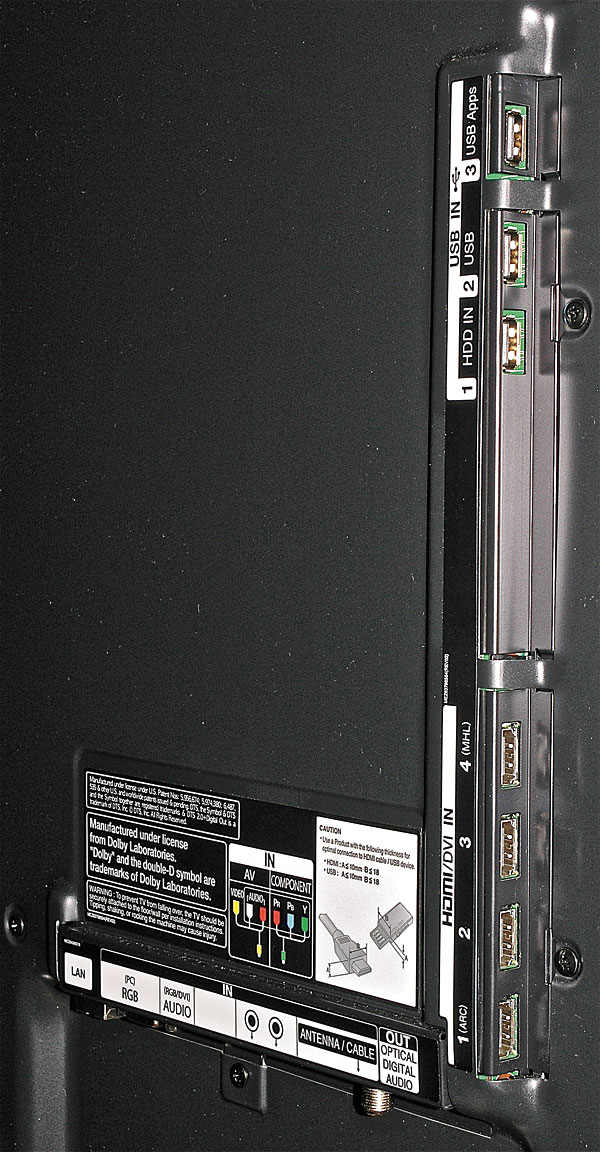
The set’s native refresh rate is a maximum of 240 hertz, but it can simulate 480 Hz with a scan- ning backlight and Dark Frame Insertion. The LG raises 24-Hz 2D sources to the set’s refresh rate via either repeating (TruMotion off) or interpolating (TruMotion on) the added frames as necessary. However, in 3D, 24-Hz sources undergo 3:2 pulldown, converting them to 60 Hz prior to display. According to LG, the set employs 8:8 pulldown with 24-Hz 3D sources.
There’s also a gamma control, although the actual gammas were lighter than their three available settings (1.9, 2.2, 2.4) would suggest. The 2.4 setting generally worked well for me, although 2.2 was preferable on some material.
Controls I didn’t use, except to confirm that I didn’t want to, included Dynamic Contrast, Dynamic Color, Super Resolution, Edge Enhancer, Noise Reduction, and MPEG Noise Reduction (the latter two might be useful with noisy sources). Two other controls, Dynamic Color and Clear White, are not available in the Expert modes.
LG’s Magic Remote, which uses a combination of RF, Bluetooth, and IR technologies, has been redesigned slightly from last year’s model. In 2011, LG also included a more conventional remote. Not now; the Magic Remote is the only one that comes standard with the 55LM9600 (though the company’s help line directs people online for purchase of a standard remote, priced around $12 to $16 each; MCMElectronics.com and SearsPartsDirect.com). By waving the Magic Remote around, much like an air mouse, you can position an onscreen cursor over the desired menu setting, which will then select and open up for adjustment. This sounds super-slick, but I found it frustrating to use on multiple levels, particularly during calibration. I requested and received a more conventional LG remote for this review.
LG’s onboard sound impressed me when I reviewed last year’s 55LW5600 (Home Theater, July 2011), and this year it’s even better. While the audio is still no match for a good outboard audio system, or even a good soundbar, it was well balanced and listenable for casual use.
LG’s passive 3D technique was first employed in the company’s 2011 sets. We explained the pro- cess extensively in our reviews of the Vizio XVT3D650SV (both Vizio and Toshiba license the process from LG) and the LG 55LW5600 (Home Theater, June and July 2011). On the plus side, the passive 3D process allows for light and cheap 3D glasses (the set comes with six pair) and produces a considerably brighter 3D image than active glasses. On the down- side, it reduces the vertical resolution seen by each eye by half (to 540 lines on material with 1080p resolution).
The 55LM9600 provides the usual 3D adjustments, including a 3D Depth control, plus some that are new to us: 3D color correction to match L&R color, six modes for 2D-to-3D conversion (as is typical, only modestly effective), and something called 3D Sound Zooming. The latter claims something about the sound coming at you out of the screen, but its effect was limited at best.
The Internet and Other Stuff
You can use LG’s Smart TV features with either a wired connection to the Internet or via the set’s built-in Wi-Fi receiver. There’s a flood of Web-based features here, including Netflix, YouTube, Vudu, Hulu Plus, Twitter, Facebook, and more. There’s also a wide range of (mostly free) 3D material, primarily in the form of short documentaries—although there’s a full performance of Mahler’s Symphony No. 1 that runs for nearly an hour.
These features are presented in an organized form on multiple tiles, plus a row of apps at the bottom. The latter include the picture adjustment settings and input selection. Push the Home button on the Magic Remote, and you get the full monty—the entire Smart TV menu that’s so extensive you have to click to the right to see all of the selections. But if you use just the remote’s Quick Menu button, only the bottom row of apps pops up.
When you select a specific Internet feature for the first time, such as YouTube or one of the 3D selections, you’ll find that the picture settings are different from those you were using before you entered the Internet app. When I first experienced this, the image was overly bright, the color excessive, and motion interpolation engaged. But you can readjust the Internet picture by selecting the Quick Menu (calling up the Home menu you’d normally use for these adjustments drops you out of the Internet and closes the app, so it’s no help).




